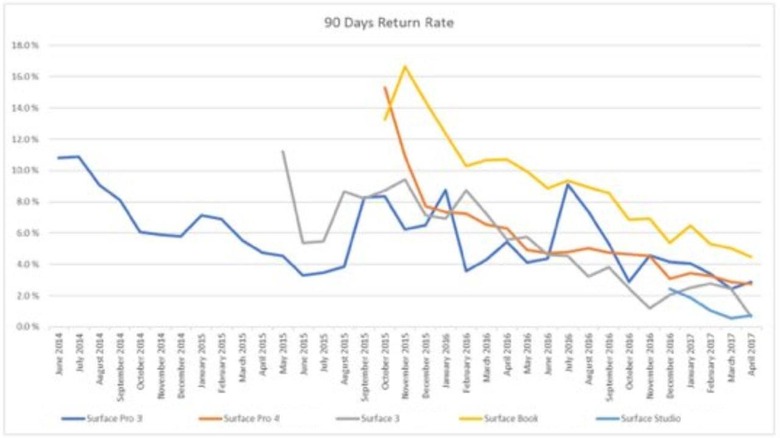This Leaked Memo Just Made Microsoft Vs Consumer Reports Fascinating
Microsoft's war over Surface reliability with Consumer Reports has taken another unexpected turn, with leaks suggesting a combination of ambition and inexperience led to higher than expected return rates. The two companies came head to head last week, after Consumer Reports took the unexpected decision to strip Microsoft's Surface Book and Surface Laptop of their "recommended" ratings, in addition to warning buyers off the Surface Pro 4. That was down to the worrying results of a survey which suggested Microsoft's laptops and tablets were the least reliable in the industry.
Unsurprisingly, Microsoft wasn't especially pleased with that characterization. Division chief Panos Panay pushed back, arguing that Surface hardware had been improving significantly in every generation and that the incidents per unit rate was dropping too. While Panay didn't give specific return numbers, he did insist that "both our predicted 1-2-year failure and actual return rates for Surface Pro 4 and Surface Book are significantly lower than 25%," the figure Consumer Reports had based its decision on.

A leaked internal memo detailing how Microsoft plans to shift the conversation, however, sheds new light onto the issue. Seen by Paul Thurrott, the document not only specifies that Microsoft experienced "some quality issues" with both the Surface Book and Surface Pro 4, but gives a chart of return rates. That indicates that the Surface Book saw a 17-percent return rate after its late-2015 launch, while Surface Pro 4 saw a slightly better 16-percent return rate.
That appears to be the fault of Intel's Skylake processors, or more accurately how Microsoft implemented them. Back in 2016, Microsoft blamed the chip-maker for the problems Surface Book and Surface Pro 4 were experiencing, issuing at least two rounds of significant driver updates. At the time, sources inside Microsoft argued that it was Intel's buggy hardware – which the Surface products were among the first to use – that caused the instabilities around power management and more.
In reality, another Microsoft source tells Thurrott, the problems came down to Microsoft's use of Skylake. They claim it was the software giant's own custom drivers and settings, created internally, that were at fault. Indeed, the extent of the issue was only recognized by senior Microsoft management when other Windows notebook OEMs confirmed that they had no complaints about Skylake whatsoever.
"The Skylake fiasco came to a head internally when Microsoft CEO Satya Nadella met with Lenovo last year and asked the firm, then the world's biggest maker of PCs, how it was dealing with the Skylake reliability issues. Lenovo was confused. No one was having any issues, he was told" Paul Thurrott
It triggered a desperate rush to get new hardware on the market, hence the release of the Surface Pro – a minor refresh over the Surface Pro 4 – and the Surface Laptop. The latter, it's claimed was an old design that Microsoft resurrected from several years previous. Thurrott also suggests that this combination of urgency and caution led to next-gen features like USB-C and Thunderbolt 3 being skipped for 2017, as Microsoft attempted to cut out as many potential headaches as possible.
In the end, criticisms of Consumer Reports' survey as a predictive tool remain valid. By polling users of existing, older hardware – the survey ended in Q1 2017, before the latest Surface Pro and Surface Laptop were even on sale – it paints a darker picture than what reliability experiences of the newest models might actually be. Nonetheless, Microsoft's attempts to whitewash its Skylake experience and apparently put the blame entirely at Intel's feet is unlikely to reassure many would-be Surface buyers.
